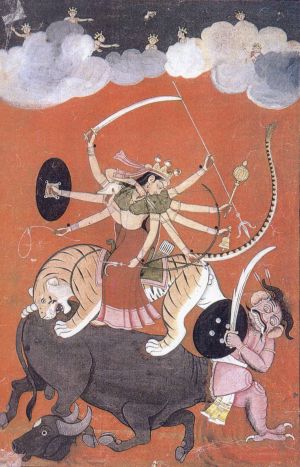Caṇḍī or Caṇḍīka is the name by which the Supreme Goddess is referred to in Devī Māhātmya, a Hindu text part of the ""Markandeya Purana"" describing the victory of the goddess Durga over the demon Mahishasura.
Etymology
According to Coburn, "Caṇḍīkā is "the violent and impetuous one", from the adjective caṇḍa "fierce, violent, cruel". The epithet is unprecedented in Vedic literature and is first found in a late insertion to the Mahabharata, where Chaṇḍā and Chaṇḍī appear as epithets. The designation of Chandi or Chandika is used twenty-nine times in the Devi Mahatmya, which is agreed by many scholars to have had originated in Bengal, the primary seat of the Shakta or Goddess tradition and tantric sadhana since ancient times. It is the most common epithet used for the Goddess. In Devi Mahatmya, Chandi, Chandika, Ambika and Durga have been used synonymously.
Description
The dhyana sloka preceding the Middle episode of Devi Mahatmya the iconographic details are given. The Goddess is described as eighteen armed bearing string of beads, battle axe, mace, arrow, thunderbolt, lotus, bow, water-pot, cudgel, lance, sword, shield, conch, bell, wine-cup, trident, noose and the discus (sudarsana). She has a complexion of coral and is seated on a lotus.
In some temples the images of Maha Kali, Maha Lakshmi, and Maha Saraswati are kept separately. The Goddess is also portrayed as four armed in many temples.
Legend
The origin of the Goddess is given in the second chapter of Devi Mahatmya.
The great Goddess was born from the energies of the male divinities when the gods became impotent in the long-drawn-out battle with the asuras. All the energies of the Gods became united and became supernova, throwing out flames in all directions. Then that unique light, pervading the Three Worlds with its lustre, combined into one, and became a female form.
The Devi projected an overwhelming omnipotence. The three eyed goddess was adorned with the crescent moon. Her multiple arms held auspicious weapons and emblems, jewels and ornaments, garments and utensils, garlands and rosaries of beads, all offered by the gods. With her golden body blazing with the splendour of a thousand suns, seated on her lion vehicle, Chandi is one of the most spectacular of all personifications of Cosmic energy.
In other scriptures, Chandi is portrayed as "assisting" Kali in her battle with demon Raktabija. While Kali drank Raktabija's blood, which created new demons on falling on the ground; Chandi would desstroy the armies of demons created from his blood and finally killed Raktabija himself. In Skanda Purana, this story is retold and another story of Chandika killing demons Chanda and Manda is added.
History
Caṇḍī or Caṇḍīika is the name by which the Supreme Goddess is referred to in Devi Mahatmya. She is one of the most popular folk deities in Bengal, and a number of poems and literary compositions in Bengali called Chandi Mangala Kavyas were written from 13th century to early 19th century. These had the effect of merging the local folk and tribal goddesses with mainstream Hinduism. The Mangal kavyas often associate Chandi with goddess Kali or Kalika. and recognize her as a consort of Shiva and mother of Ganesha and Kartikeya, which are characteristics of goddesses like Parvati and Durga. The concept of Chandi as the supreme Goddess also underwent a change. The worship of the goddess became heterogeneous in nature.
References
- Coburn, Thomas B., Devī Māhātmya, The Crystallization of the Goddess Tradition , South Asia Books, 2002. (ISBN 81-208-0557-7)
- Manna, Sibendu, Mother Goddess, Chaṇḍī, Punthi Pustak, Calcutta, India, 1993. (ISBN 81-85094-60-8)
- Mookerjee, Ajit, Kali, The Feminine Force, Destiny Books, Rochester, Vermont, 1988.
- Sankaranarayanan, S., Glory of the Divine Mother (Devī Māhātmyam), Nesma Books, India, 2001. (ISBN 81-87936-00-2)
- McDaniel, June, Offering Flowers, Feeding Skulls: Popular Goddess Worship in West , Published 2004, Oxford University Press - US, 368 pages, ISBN 0-19-516790-2
- McDaniel, June, Making Virtuous Daughters and Wives: An Introduction to Women's Brata Rituals in Benegal Folk Religion, Published 2002, SUNY Press, 144 pages, ISBN 0-7914-5565-3
- Wilkins, William Joseph, Hindu Mythology, Vedic and Puranic, Published 2004, Kessinger Publishing, 428 pages, ISBN 0-7661-8881-7 (First edition: Published 1882; Thacker, Spink & co.)

